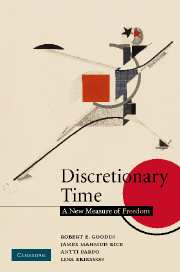Book contents
- Frontmatter
- Contents
- List of figures
- List of tables
- Preface
- Part I Introduction
- Part II Time pressure
- 4 Time pressure: a new problem?
- 5 Time pressure: a new measure
- 6 Is it really an illusion?
- Part III Welfare regimes matter
- Part IV Gender regimes matter
- Part V Household regimes matter
- Part IV Conclusions
- Appendix 1 Methodology
- Appendix 2 Data
- Bibliography
- Index
6 - Is it really an illusion?
Published online by Cambridge University Press: 28 October 2009
- Frontmatter
- Contents
- List of figures
- List of tables
- Preface
- Part I Introduction
- Part II Time pressure
- 4 Time pressure: a new problem?
- 5 Time pressure: a new measure
- 6 Is it really an illusion?
- Part III Welfare regimes matter
- Part IV Gender regimes matter
- Part V Household regimes matter
- Part IV Conclusions
- Appendix 1 Methodology
- Appendix 2 Data
- Bibliography
- Index
Summary
Economists have coined the phrase ‘the money illusion’. That refers to the way in which people often mistakenly cue on the amount of money that they are offered, rather than on what that amount of money will buy for them. The money itself is no illusion. That is indeed what they are being offered. The illusion lies in their conflating two things (there, money and consumption opportunities) which are not the same and which can sometimes come dramatically apart. And insofar as they do, focusing on the money rather than what the money will buy you amounts to focusing on the wrong thing. It amounts to fetishizing money, when (at least for most of us) money is only of value by virtue of what it can buy for us.
We offer our notion of the ‘time-pressure illusion’ in a similar spirit. By that, we refer to the difference between the ‘time pressure’ that people actually experience (in terms of their actual ‘spare time’) and that which they strictly need to experience (in terms of their ‘discretionary time’). As with the money illusion, so too with the time-pressure illusion: the time pressure that people actually experience is not in the least illusory. People really are spending all those hours in paid labour, unpaid household labour and personal care; they really only do have that many hours to spare, in their actual lives.
- Type
- Chapter
- Information
- Discretionary TimeA New Measure of Freedom, pp. 99 - 112Publisher: Cambridge University PressPrint publication year: 2008



